Berlin Wall Worksheets
Do you want to save dozens of hours in time? Get your evenings and weekends back? Be able to teach about the Berlin Wall to your students?
Our worksheet bundle includes a fact file and printable worksheets and student activities. Perfect for both the classroom and homeschooling!
Resource Examples
Click any of the example images below to view a larger version.
Fact File
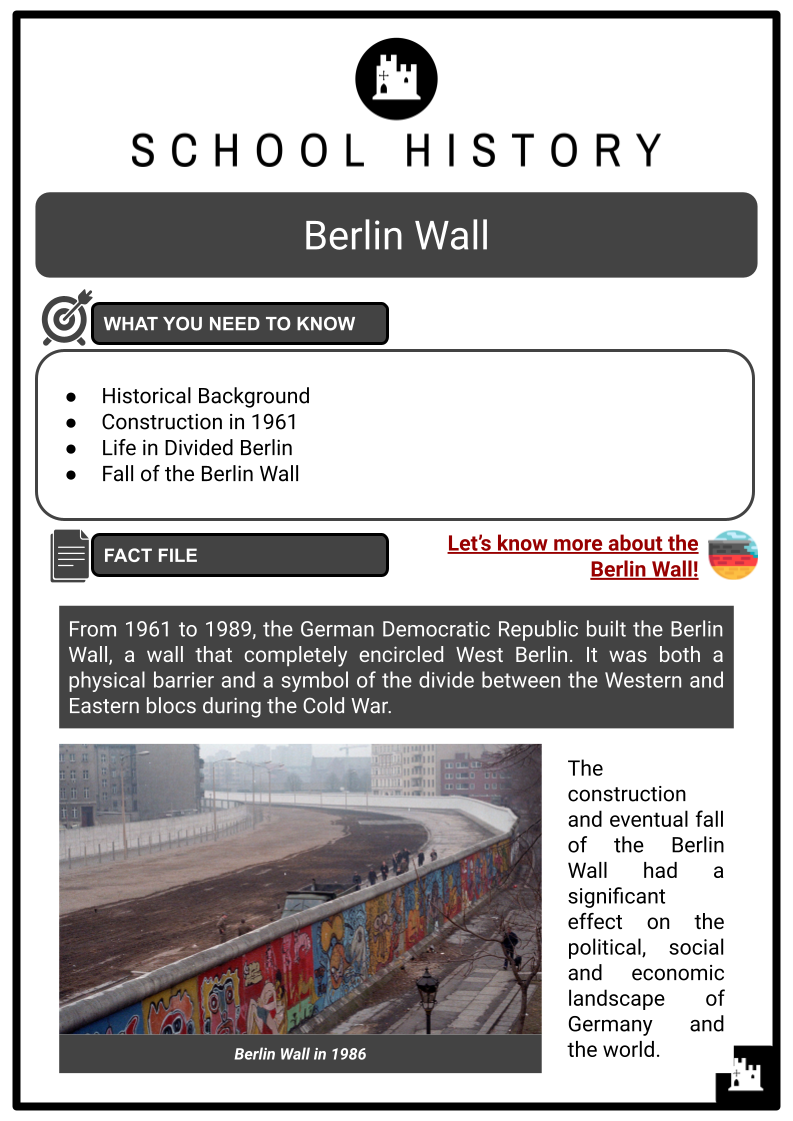
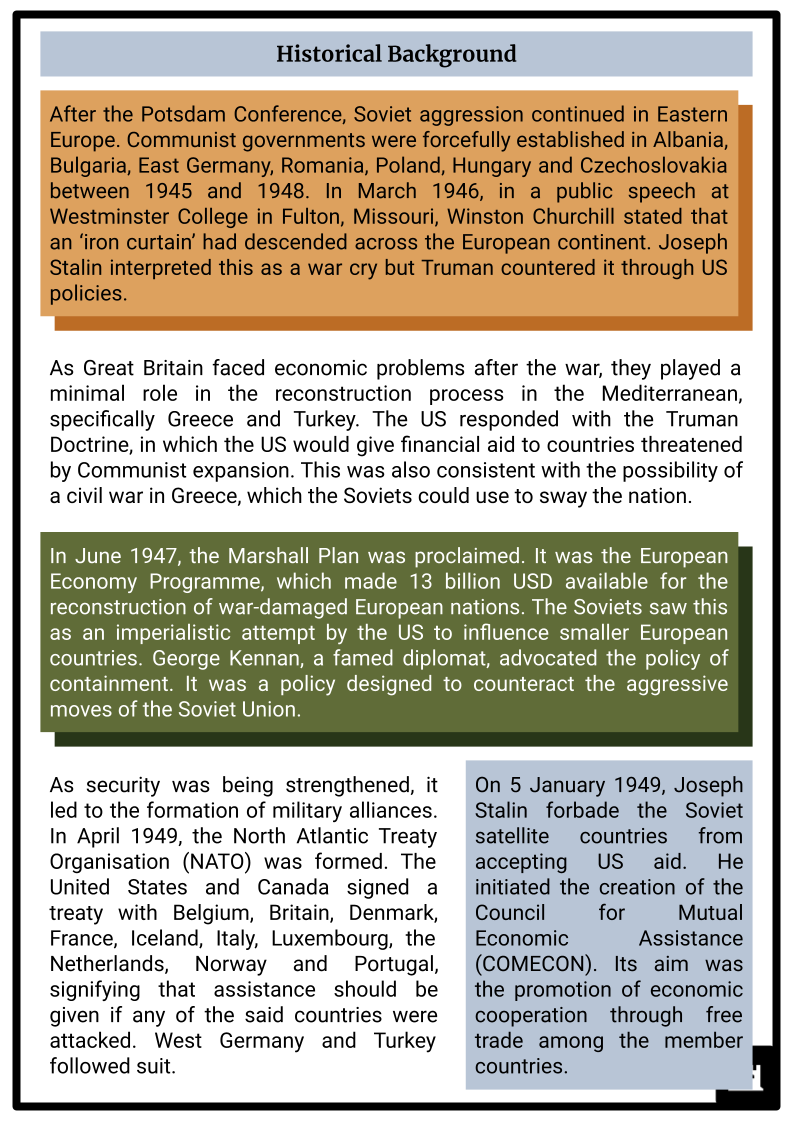
Student Activities
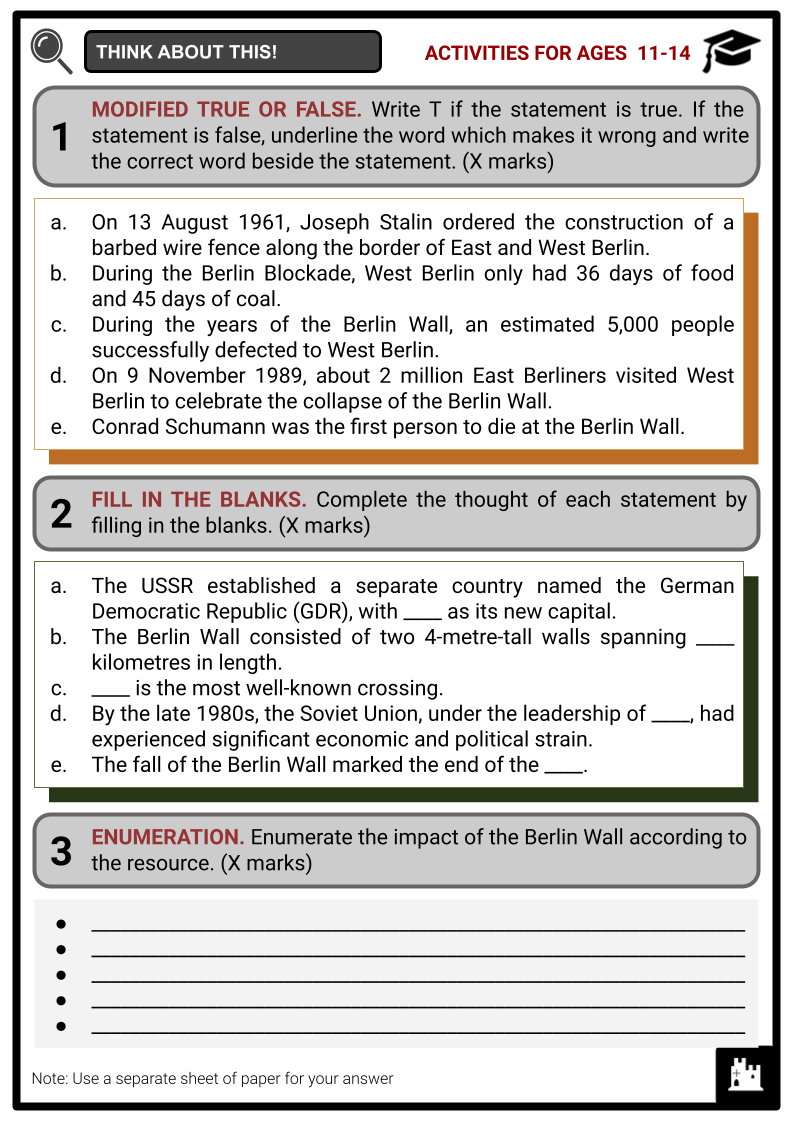
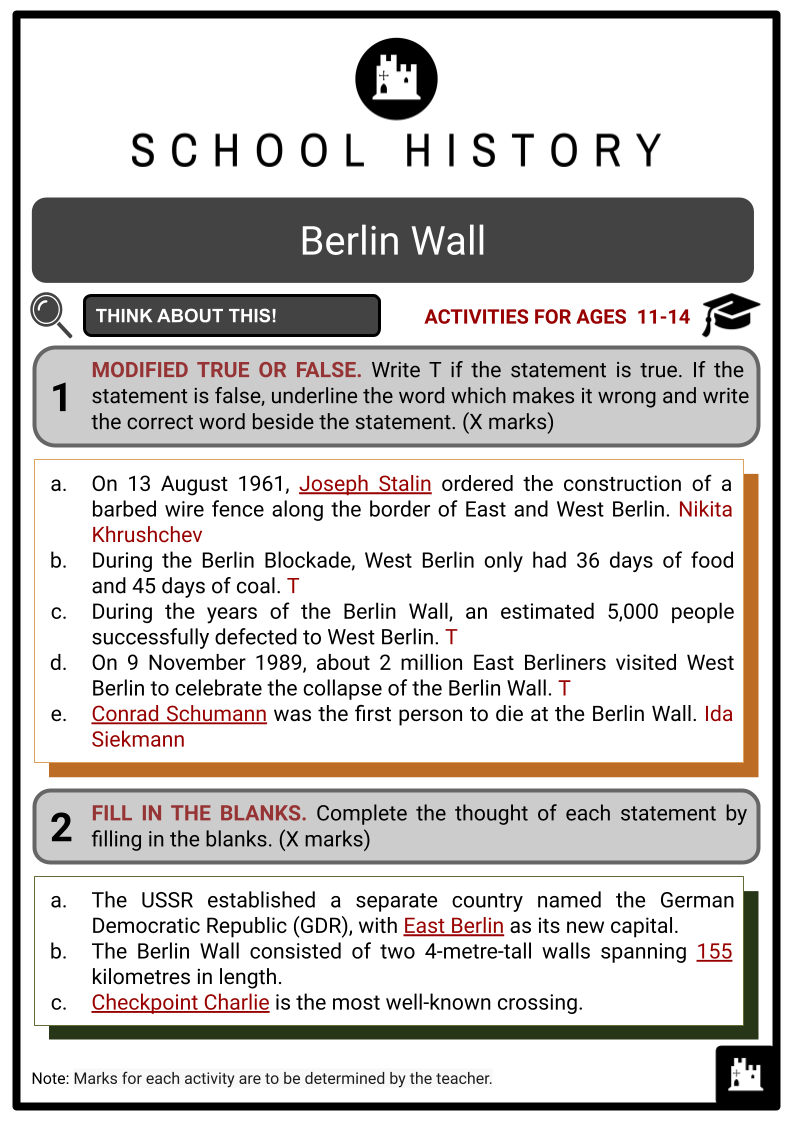
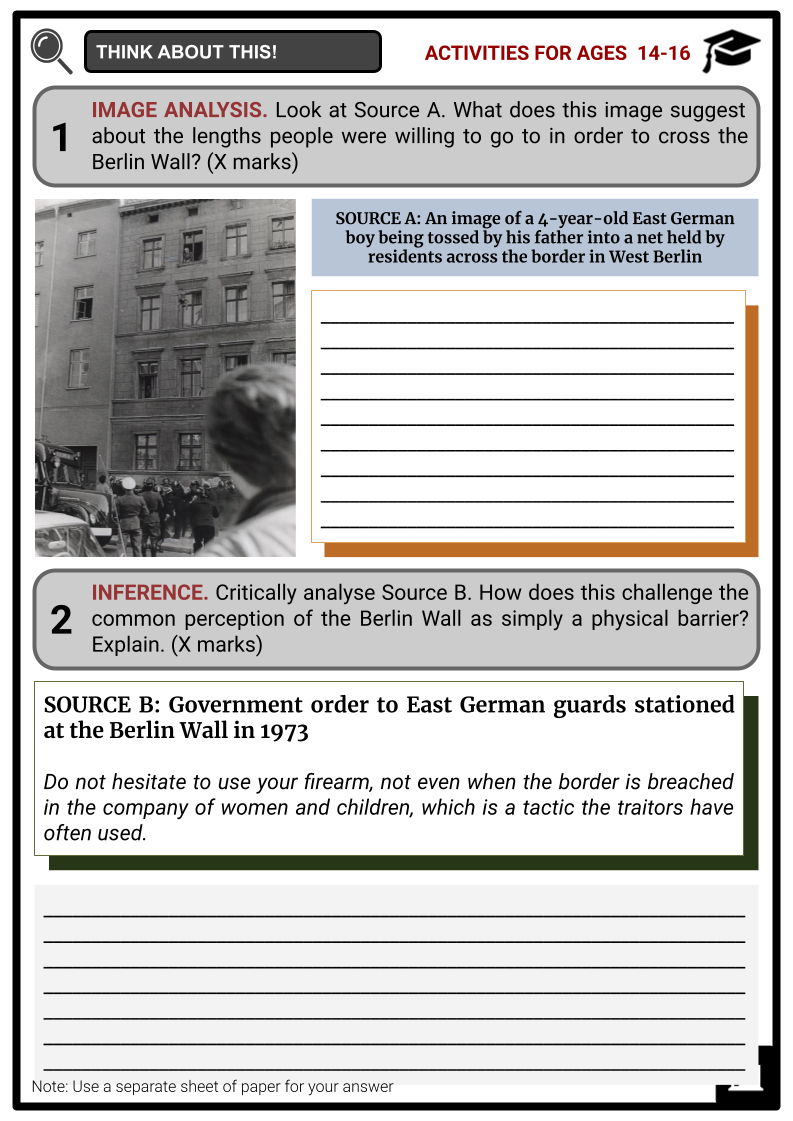

Summary
- Historical Background
- Construction in 1961
- Life in Divided Berlin
- Fall of the Berlin Wall
Key Facts And Information
Let’s know more about the Berlin Wall!
From 1961 to 1989, the German Democratic Republic built the Berlin Wall, a wall that completely encircled West Berlin. It was both a physical barrier and a symbol of the divide between the Western and Eastern blocs during the Cold War. The construction and eventual fall of the Berlin Wall had a significant effect on the political, social and economic landscape of Germany and the world.
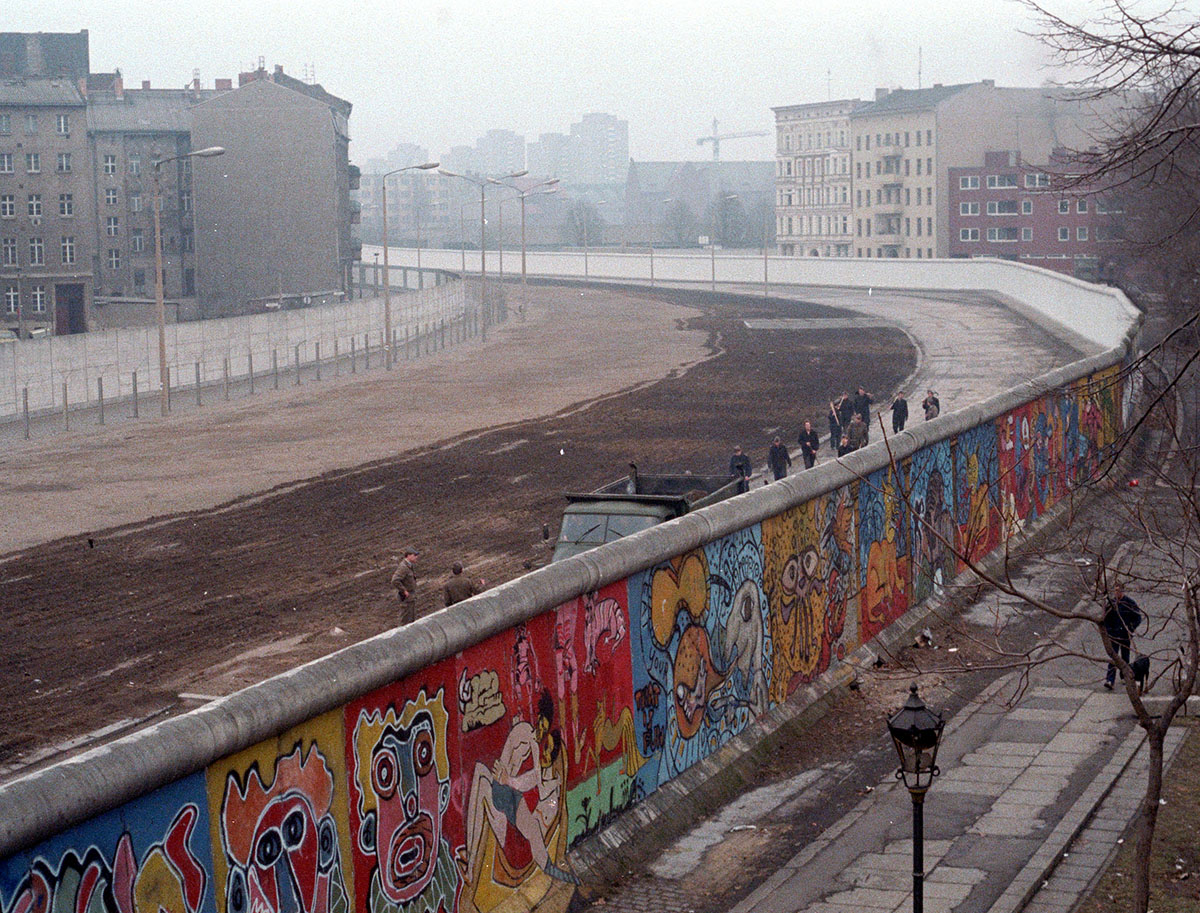
Historical Background
- After the Potsdam Conference, Soviet aggression continued in Eastern Europe. Communist governments were forcefully established in Albania, Bulgaria, East Germany, Romania, Poland, Hungary and Czechoslovakia between 1945 and 1948. In March 1946, in a public speech at Westminster College in Fulton, Missouri, Winston Churchill stated that an ‘iron curtain’ had descended across the European continent. Joseph Stalin interpreted this as a war cry but Truman countered it through US policies.
- As Great Britain faced economic problems after the war, they played a minimal role in the reconstruction process in the Mediterranean, specifically Greece and Turkey. The US responded with the Truman Doctrine, in which the US would give financial aid to countries threatened by Communist expansion. This was also consistent with the possibility of a civil war in Greece, which the Soviets could use to sway the nation.
- In June 1947, the Marshall Plan was proclaimed. It was the European Economy Programme, which made 13 billion USD available for the reconstruction of war-damaged European nations. The Soviets saw this as an imperialistic attempt by the US to influence smaller European countries. George Kennan, a famed diplomat, advocated the policy of containment. It was a policy designed to counteract the aggressive moves of the Soviet Union.
- As security was being strengthened, it led to the formation of military alliances. In April 1949, the North Atlantic Treaty Organisation (NATO) was formed. The United States and Canada signed a treaty with Belgium, Britain, Denmark, France, Iceland, Italy, Luxembourg, the Netherlands, Norway and Portugal, signifying that assistance should be given if any of the said countries were attacked. West Germany and Turkey followed suit.
- On 5 January 1949, Joseph Stalin forbade the Soviet satellite countries from accepting US aid. He initiated the creation of the Council for Mutual Economic Assistance (COMECON). Its aim was the promotion of economic cooperation through free trade among the member countries.
- The United States, the United Kingdom, France and the Soviet Union kept meeting to conclude a final peace treaty with Germany. This resulted in Germany being divided into four occupation zones: Great Britain in the northwest, the Soviet Union in the east, the United States in the south, and France in the southwest. They exercised sovereign power over these zones, which were treated as one country as per their 1937 territorial rights prior to Nazi expansion.
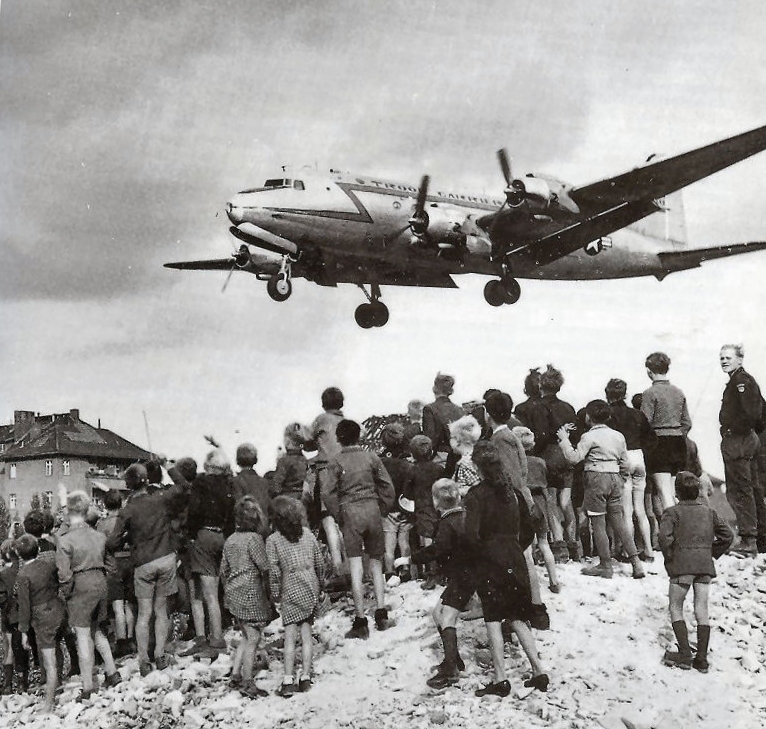
- By February 1948, the British, French and American governments began to merge their zones economically to unify them and form a national government. In response, the Soviet Union imposed a blockade of Berlin to halt the process of unifying West Germany and to secure the Soviet-controlled territory in the eastern zone.
- The Berlin Blockade became one of the major crises during the Cold War. The Soviet Union blocked Allied access to West Berlin, which resulted in shortages of commodities including food, medicine and fuel. At that time, West Berlin only had 36 days of food and 45 days of coal. The Allies, at first, had 3 choices: (1) surrender their sectors to the communists; (2) let the city starve; or (3) act proactively, risking another war.
- They went for neither and chose to supply all of Berlin using the airlift method. So over the next 321 days, starting on 24 June 1948, the Allies airlifted supplies into Berlin using 275,000 flights to deliver 4,000 tonnes of supplies each day.
- Stalin underestimated the resources of the Allies and believed that an airlift was impossible. They set up three air corridors in Berlin but did not shoot any planes down in the time period, fearing that it would lead to another war. Despite Stalin’s blockade, many West Berliners attempted to leave the western side of Berlin. The city council and many students and teachers from Berlin University in the East established a new Free University in the West. As a result, Stalin lifted the blockade on 12 May 1949.
- Within a few weeks, West Germany and Communist East Germany both became independent nations. West Germany declared itself the Federal Republic of Germany (FRG), with Bonn as its capital. Meanwhile, the USSR established a separate country named the German Democratic Republic (GDR), with East Berlin as its new capital.
- As opposed to East Germany, West Germany evolved into a social market economy and democratic parliamentary administration, typical of a Western capitalist nation. In 1953, a growing number of GDR inhabitants fled to West Germany out of concern for additional Sovietisation.
- The majority of Eastern Bloc republics, including East Germany, adopted the Soviet strategy of limiting emigration in order to manage national movement at the beginning of the 1950s. As a result, a barbed-wire barrier was erected, and the inner German border between the two German states was closed. Berlin developed into a hotbed of friction between the US and the USSR as well as a draw for East Germans wishing to flee the GDR.
- The Soviets gave East Germany control over civilian movement in Berlin in 1955, transferring authority to a dictatorship that the West did not recognise. After a considerable number of East Germans defected (known as the Republikflucht), the new East German state constitutionally barred almost all travel to the West in 1956. The 3.5 million East Germans who departed by 1961 accounted for around 20% of all East Germans, and the Berlin sector boundary became a ‘loophole’ through which members of the Eastern Bloc could still flee.
- The number of East German intelligentsia among the refugees increased significantly by 50% as a result of the ‘brain drain’ that young, educated emigration to East Germany caused. Merely 61% of the populace was of working age in 1960, with a disproportionate number of professionals in this category. West Germany owed $17 billion in compensation, but the direct cost of East Germany’s labour losses was estimated to be $7 billion to $9 billion.
- The division of Germany into East and West had profound economic impacts, with East Germany suffering from a significant loss of skilled professionals and a subsequent decrease in its economic productivity and development. The Berlin Wall symbolised the physical and ideological division between East and West Germany during the Cold War.
Construction in 1961
- A number of East Germans sought to escape poverty-stricken East Germany (GDR). They wanted to flee to West Germany, as it was described as being prosperous due to Western control. In response to the migration to West Germany, on 13 August 1961, Nikita Khrushchev, the leader of the Soviet Union, ordered the construction of a barbed wire fence along the border of East and West Berlin. This fence was just the beginning, as it eventually evolved into the parallel walls and extensive fortifications that became known as the Berlin Wall.
- The East German government feared the appeal of the economic miracle of the West and that its citizens would attempt to move. Both communism and capitalist spies from the East alarmed West Germans at the same time. In 1961, Khrushchev publicly announced that Berlin was part of East Germany. He also warned the West German government against taking military action. In response to the threat, the West German government decided to also build a wall that they called an ‘anti-fascist protective wall’.
- The USSR ordered the placement of fences, trenches and watchtowers along the wall. Guards were authorised to shoot anyone attempting to cross it. The barrier consisted of two 4-metre-tall walls spanning 155 kilometres in length. The ‘death strip’, a mine corridor with sand or gravel covering it, stood between these two walls and helped guards spot trespassers and maintain clear firefields. Along with barbed wire, dogs on long leashes, mesh fencing, signal fencing, anti-vehicle trenches, watchtowers and bunkers manned by hundreds of Soviet guards supplemented the wall.
- There were nine border crossings where West Berliners, West Germans, Western foreigners, Allied soldiers and GDR nationals could enter East Berlin as long as they had the required authorisation. Checkpoint Charlie is the most well-known crossing, and it was only open to foreigners and Allied soldiers. Other crossings allowed movement with a permit between West Germans and West Berlin, as well as between West Berliners and East Germans.
- New crossings were created for rubbish transfer and access to West Berlin’s exclaves after agreements in 1972. There were ferry and train lines that led to West Berlin. The wall divided Berlin’s public transportation systems, with three western lines passing through East Berlin. During the 1980s, visitors from other countries, including West Germans, could enter East Germany without a visa if they applied several weeks in advance at an East German embassy. However, officials in East Germany had the right to deny entry permits for any reason.
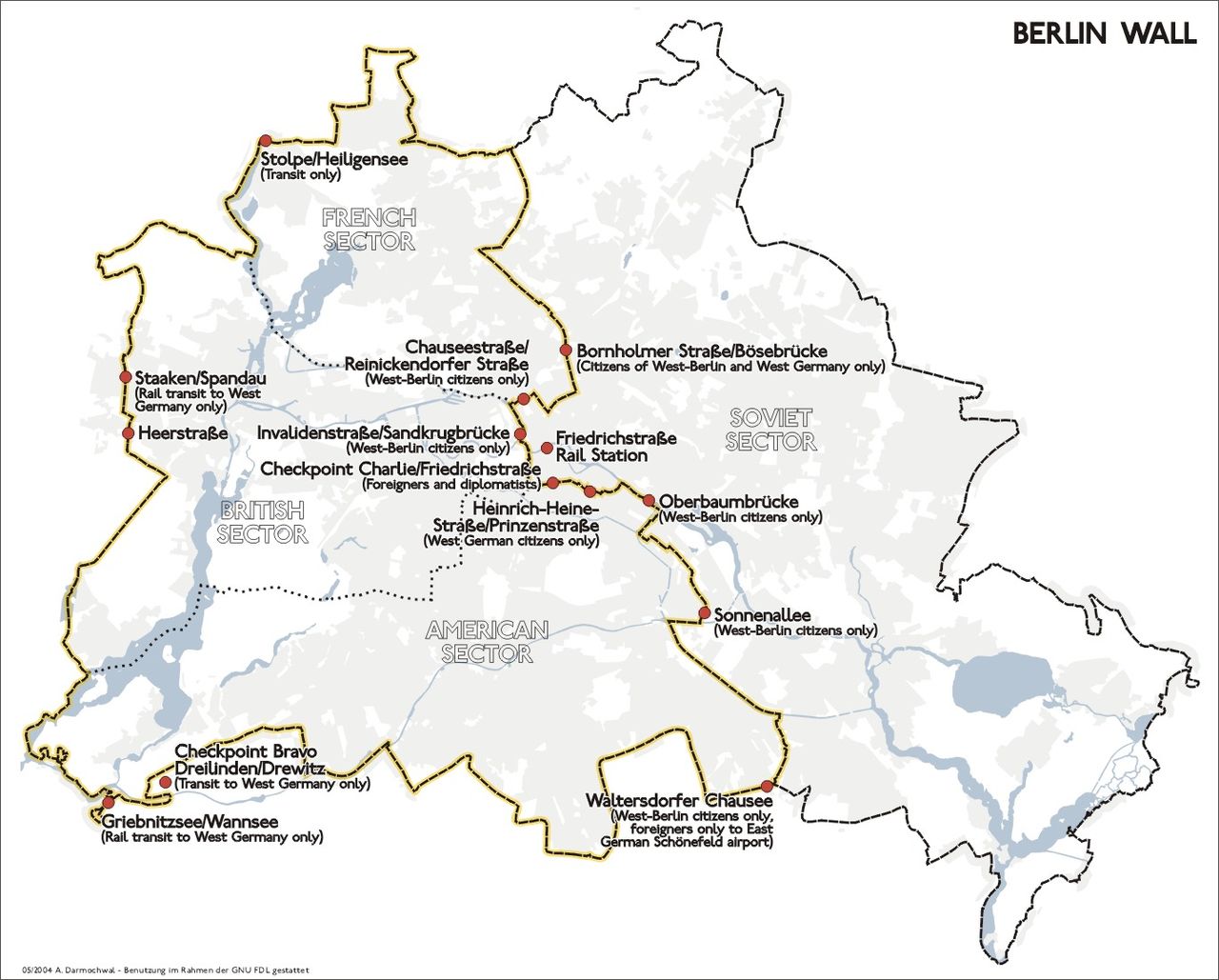
- Over time, a number of exclusions were added, including those for ageing retirees, family members travelling for urgent business, and anyone needing to travel to the West. Citizens of the GDR were required to seek individual approval, which was never assured.
Life in Divided Berlin
- The division of Berlin by the construction of the Berlin Wall created a stark contrast in the way of life between East and West Berlin. West Berlin, under the influence of the Western powers, experienced economic prosperity and became a vibrant hub of culture and freedom.
- On the other hand, East Berlin was known for having a more authoritarian government, fewer personal freedoms and a struggling economy.
- The presence of the Berlin Wall not only physically divided the city but also created psychological and emotional barriers among families and friends who found themselves on opposite sides. Many families were separated, and the ability to freely visit and communicate with loved ones became severely restricted.
- While West Berlin thrived and received significant support from the Western Allies, East Berlin struggled with economic challenges and political oppression. The strict control by the East German government led to a pervasive atmosphere of surveillance and fear among its citizens. Basic amenities and consumer goods were scarce, and the overall standard of living was considerably lower compared to the West.
- Amid these heightened security measures, numerous daring individuals made desperate attempts to defect to the West. The allure of freedom, economic opportunities and personal liberties in the West motivated these individuals to risk their lives in pursuit of a better future.
- Some of the first successful escapes involved leaping out of apartment windows along the line or jumping the first barbed wire. Conrad Schumann was the first border guard from East Germany to cross the barbed wire and reach West Berlin on 15 August 1961. Ida Siekmann, who died after jumping out of her flat at 48 Bernauer Strasse on the third floor, was the first person to die at the Berlin Wall.
- East Germans successfully escaped the country using a variety of methods, including protracted tunnelling beneath the wall, hot air balloon rides in favourable winds, gliding along aerial lines, flying ultralight aircraft, and accelerating through the first, basic defences in a sports car. Only 19 of the at least 70 tunnels that were excavated beneath the wall were effective in letting runaways escape.
- During the years of the Wall, an estimated 5,000 people successfully defected to West Berlin, and over 200 people are said to have died in the process (140 of these deaths have been documented).
- Impact of the Berlin Wall:
- Years were lost for families who were separated by the wall.
- Those who tried to escape the East were either imprisoned or killed.
- Industrial and agricultural production in the East gradually increased.
- The possibility of a nuclear war was averted.
- East Berliners began to accept their life in East Germany.
Fall of the Berlin Wall
- By the late 1980s, the Soviet Union, under the leadership of Mikhail Gorbachev, had experienced significant economic and political strain. Gorbachev’s policies of glasnost (openness) and perestroika (restructuring) loosened the Soviet grip on its satellite states in Eastern Europe.
- Simultaneously, the people of East Germany were becoming increasingly disillusioned with the repressive regime and were expressing their dissent through peaceful demonstrations and civil disobedience. The calls for social and political change were growing louder, and the long-standing grip of the East German government was beginning to loosen.
- One of the pivotal moments leading to the fall of the Berlin Wall was the mass exodus of East Germans to West Germany through Hungary. The Hungarian government relaxed border restrictions with Austria in the summer of 1989, allowing East German citizens to escape to the West through Hungary. This sparked a wave of defections and mass emigration that put immense pressure on the East German government.
- The protest movement gained momentum in East Germany, with citizens organising peaceful demonstrations and demanding political reforms. The demonstrations culminated in mass protests in East Berlin and other cities, where hundreds of thousands of people took to the streets, calling for freedom, democracy and the reunification of Germany.
- Under mounting pressure, the East German government was compelled to open the border crossings. On 9 November 1989, about 2 million East Berliners visited West Berlin to celebrate the collapse of the Berlin Wall. Most were equipped with hammers and picks, while others brought cranes and bulldozers to break down sections of the wall.
- On 3 October 1990, nearly a year after the fall of the wall, the reunification of East and West Germany was made official. The fall of the Berlin Wall marked the end of the Cold War.
Frequently Asked Questions
- What was the Berlin Wall?
The Berlin Wall was a concrete barrier that divided Berlin from 1961 to 1989. It separated East Berlin, controlled by the communist government of East Germany, from West Berlin, which was part of democratic West Germany.
- Why was the Berlin Wall built?
The Berlin Wall was built by the East German government to prevent East Germans from fleeing to West Berlin and, by extension, to the more prosperous and democratic West Germany. This mass exodus threatened East Germany's stability and economy.
- How did the Berlin Wall affect the lives of people in Berlin?
The Berlin Wall separated families, friends, and communities, disrupting lives and creating a symbol of the Cold War's division between East and West. Many East Germans faced severe consequences if they attempted to escape to the West.
